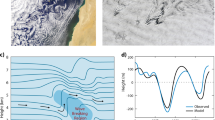Summary
The problem of representing the drag due to subgridscale orography is examined. Results from model simulations are used to illustrate clear deficiencies in the global angular momentum budgets and possible ways of correcting for these deficiencies are considered. It is argued that a formulation for the stress due to subgridscale gravity waves is required, as was first recognized by Boer et al. (1984a, b), and the impact of a scheme based on Palmer et al. (1986) is presented. The scheme is improved by using directionally-dependent subgridscale orographic variances. Results from 90-day integrations using the ECMWF and UKMO models with similar resolutions are very much in accord both with and without a wave drag parametrization scheme; showing much improved wintertime circulations.
The relationship between the wave drag and the model orography is examined with the use of idealized stress profiles whereby the wave drag is limited to either near the surface or in the stratosphere. A combination of parametrized wave drag with an envelope orography performs best at this stage of development.
Results are presented from a substantial series of ten-day forecast experiments with the ECMWF operational model using mean and (1 σ) envelope orographies, these show significant improvements in forecast skill.
Similar content being viewed by others
References
Boer, G. J., McFarlane, N. A., Laprise, R., Henderson, J. D., Blanchet, J.-P., 1984a. The Canadian Climate Centre Spectral Atmospheric General Circulation Model.Atmosphere-Ocean,22, 397–429.
Boer, G. J., McFarlane, N. A., Laprise, R., Henderson, J. D., Blanchet, J.-P., 1984b: The Climatology of the Canadian Climate Centre General Circulation Model as obtained from a Five-Year Simulation.Atmosphere-Ocean,22, 430–473.
Booker, J. R., Bretherton, F. P., 1967: The critical layer for internal gravity waves in a shear flow.J. Fluid Mech.,27, 513–539.
Bretherton, F. P., 1969: Momentum transport by gravity waves.Quart. J. R. Meteor. Loc.,95, 21–234
Charney, J. G., Drazin, P. G., 1961. Propagation of planetary scale disturbances from the lower into the upper atmospehre.J. Geophys. Res.,66, 83–109.
Chouinard, C., Beland, M., McFarlane, N. A., 1986: A simple gravity wave drag parametrization for use in medium-range weather forecast models.Atmosphere-Ocean,24, 91–110.
Cubasch, U., 1981: The performance of the ECMWF model in 50 day integrations. ECMWF Tech. Memo. No. 32, 74 pp.
ECMWF, 1986: Seminar/Workshop proceedings, Observation, theory and modelling or orographic effects, 15–20 September 1986, 333 pp.
Hoskins, B. J., McIntyre, M. E., Robertson, A., 1985: On the use and significance of isentropic potential vorticity maps.Quart. J. R. Meteor. Soc.,111, 877–946.
Jeffries, H., 1933: The function of cyclones in the general circulation (reprinted in “Theory of thermal convection”, ed. Barry Saltzman, 1962. Dover Publications Inc., 200–213.
Lau, N.-C., White, G. H., Jenne, R. L., 1981: Circulation statistics for the extratropical northern hemisphere, based on NMC analyses. Tech. Note TN-171-STR, NCAR, Boulder, Colorado.
Lilly, D. K., 1972: Wave momentum flux—a GARP problem.Bull. Am. Meteor. Soc. 53, 17–23.
Lindzen, R. S., 1981: Turbulence and stress due to gravity wave and tidal breakdown.J. Geophys. Res.,86, 9707–9714.
Manabe, S., Hahn, D. G., 1981: Simulation of atmospheric variability.Mon. Wea. Rev.,109, 2260–2286.
McFarlane, N. A., Girard, C., Shantz, D. W., 1986: Reduction of systematic errors in NWP and General Circulation Models by parametrized gravity wave drag. J. Met. Soc. Japan, “Short- and Medium-range Numerical Weather Prediction” WMO/IUGG Symposium, August 1986, 713–728.
McFarlane, N. A., 1987: The effect of orographically excited gravity wave drag on the general circulation of the lower stratosphere and troposphere.J. Atmos. Sci.,44, 1775–1800.
Palmer, T. N., Shutts, G. J., Swinbank, R., 1986: Alleviation of a systematic westerly bias in general circulation and numerical weather prediction models through an orographic gravity wave drag parametrization.Quart. J. R. Meteor. Soc.,112, 1001–1039.
Pitcher, E. J., Malone, R. C., Ramanathan, V., Blackmon, M. L., Pain, K., Bourke, W., 1983: January and July simulations with a spectral general circulation model.J. Atmos. Sci.,40, 580–604.
Shutts, G., 1986: Parameterization of sub-grid scale gravity wave momentum transfer and its influence in forecast/climate models. ECMWF Seminar 1985 167–198.
Simmons, A. J., Jarraud, M., 1983: ECMWF Seminar on Numerical Methods for Weather Prediction, Vol. 2, 113–165.
Slingo, A., 1985: Handbook of the Meteorological Office 11-layer atmospheric general circulation models. Met. O 20 DCTN 29. Meteorological Office, Bracknell.
Slingo, A., Pearson, D. W., 1987: A comparison of the impact of an envelope orography and of a parametrization of gravity-wave drag on simulations with an atmospheric general circulation model.Quart. J. R. Meteor. Soc.,113, 847–870.
Tibaldi, S., 1986: Envelope orography and maintenance of quasi-stationary waves in the ECMWF model.Adv. Geophys.,29, 339–374.
Von Storch, H., Roeckner, E., Cubasch, U., 1985: Intercomparison of extended-range January simulations with general circulation models: statistical assessment of ensemble properties.Beitr. Phys. Atmosph.,52, 262–286.
Wallace, J. M., Tibaldi, S., Simmons, A. J., 1983: Reduction of systematic errors in the ECMWF model through the introduction of an envelope orography.Quart. J. Roy. Meteor. Soc.,109, 683–717.
Author information
Authors and Affiliations
Additional information
With 26 Figures
Rights and permissions
About this article
Cite this article
Miller, M.J., Palmer, T.N. & Swinbank, R. Parametrization and influence of subgridscale orography in general circulation and numerical weather prediction models. Meteorl. Atmos. Phys. 40, 84–109 (1989). https://doi.org/10.1007/BF01027469
Received:
Revised:
Issue Date:
DOI: https://doi.org/10.1007/BF01027469




